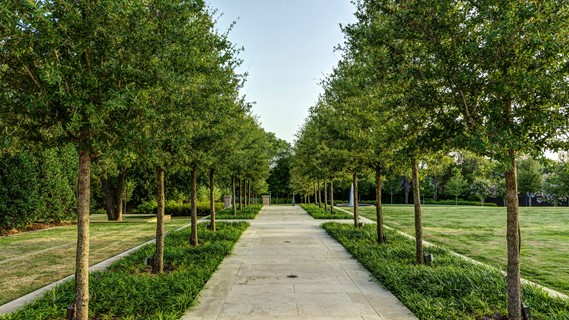The 2-Minute Rule for Hilton Head Landscapes
The 2-Minute Rule for Hilton Head Landscapes
Blog Article
Not known Details About Hilton Head Landscapes
Table of Contents9 Easy Facts About Hilton Head Landscapes ExplainedThe Ultimate Guide To Hilton Head LandscapesHilton Head Landscapes Fundamentals ExplainedSome Ideas on Hilton Head Landscapes You Need To KnowSome Of Hilton Head Landscapes7 Easy Facts About Hilton Head Landscapes ExplainedThe Definitive Guide for Hilton Head Landscapes
Line develops all types and patterns and can be utilized in a selection of means in the landscape. Line in the landscape is created by the edge in between 2 products, the outline or silhouette of a type, or a lengthy straight attribute. Lines are a powerful tool for the developer because they can be made use of to produce an unlimited range of shapes and forms, and they manage activity of the eye and the body.

Lines can have several attributes, such as those described listed below, however they commonly serve various functions. Number 1. Lines in the landscape - landscape design hilton head. The properties of lines determine how individuals reply to the landscape, both emotionally and literally. Straight lines are architectural and forceful; they produce a formal character, are generally associated with a symmetrical style, and lead the eye straight to a centerpiece.
The Main Principles Of Hilton Head Landscapes
Rounded lines create an informal, all-natural, kicked back personality that is associated much more with nature and asymmetrical equilibrium. Curved lines move the eye at a slower speed and add secret to the area by developing surprise views.
Upright lines in the landscape include high, slim plant material, such as trees, or tall frameworks, such as an arbor or a bird house on a post. Horizontal lines relocate the eye along the ground aircraft and can make a room feel bigger. Low lines are much more restrained and develop a feeling of rest or repose.
The Of Hilton Head Landscapes
Low lines are developed by reduced garden wall surfaces, walkways, and brief bushes. Lines are used to attract kinds on a plan. In plan view, they specify plant beds and hardscape areas. Lines are likewise developed by the upright types of constructed features and plant product. There are 3 primary line kinds that develop type in the landscape: bedlines, hardscape lines, and plant lines.
Bedlines connect plant material to your home and hardscape because the eye complies with the line, moving the look via the landscape. Hardscape lines are produced by the edge of the hardscape, which defines the built structure. Line can additionally be developed by long and narrow materials, such as a fence or wall surface.
Everything about Hilton Head Landscapes
Form is located in both hardscape and plants, and it is generally the leading aesthetic component that spatially organizes the landscape and often establishes the style of the garden. The type of structures, plant beds, and garden ornaments additionally identifies the overall kind theme of the garden. Formal, geometric forms include circles, squares, and polygons.
Plants create type in the garden through their lays out or silhouettes, but type can additionally be specified by a void or negative area in between plants - hilton head landscapers (https://worldcosplay.net/member/1787568). Circles can be cycles, or they can be divided right into half circles or circle segments and integrated with lines to develop arcs and tangents
The Basic Principles Of Hilton Head Landscapes
Circles are a strong style kind because the eye is always attracted to the center, which can be made use of to emphasize a focal factor or link other kinds. Circular forms in hardscape and grass panels.
The square type can likewise be fractional and previously owned repetitively to produce a grid pattern. Unlike circles, squares are more powerful on recommended you read the sides, which can be lined up or overlapped to develop unique patterns and even more complicated types.
Meandering lines frequently resemble the all-natural course of rivers or streams and can be referred to as smooth lines with deeply bent wavinesses. Twisting lines (Number 3) function well for paths, plant bedlines, and completely dry stream beds. Twisting lines can include rate of interest and enigma to a yard by leading customers around corners to discover brand-new sights and spaces.
Rumored Buzz on Hilton Head Landscapes

Figure 5. Fragmented edges: stepping rocks in pathway. Type is the most enduring quality of a plant (Landscapers near me). https://www.4shared.com/u/jPjMNmnZ/stevenagonzales.html. Common plant kinds are well established and standardized, as kind is the most consistent and identifiable characteristic of plants. Type can additionally be produced through the massing of plants, where the total mass develops a different kind than a private plant.
An extremely different kind must be used with careone or 2 job well as a prime focus, but a lot of produce turmoil. All-natural plant kinds, as opposed to over-trimmed kinds, must develop the mass of the make-up. The relevance of overall type is a lot more or much less depending on the watching perspectivethe form of a tree can appear quite different to a person standing under the canopy versus viewing the tree from a range in an open field.
Rumored Buzz on Hilton Head Landscapes
Plant types likewise produce and define deep space or open spaces in between the plants, producing either convex or concave forms in the voids. High-arching tree branches usually create a concave open space under the branches, and a rounded cover with low branches fills the space to produce a convex form outdoors area under the tree.

Report this page